Mapping intellectual structure and research hotspots in the field of fibroblast-associated DFUs: a bibliometric analysis
- PMID: 37124747
- PMCID: PMC10140415
- DOI: 10.3389/fendo.2023.1109456
Mapping intellectual structure and research hotspots in the field of fibroblast-associated DFUs: a bibliometric analysis
Abstract
Background: Diabetic foot ulcers (DFUs) are one of the most popular and severe complications of diabetes. The persistent non-healing of DFUs may eventually contribute to severe complications such as amputation, which presents patients with significant physical and psychological challenges. Fibroblasts are critical cells in wound healing and perform essential roles in all phases of wound healing. In diabetic foot patients, the disruption of fibroblast function exacerbates the non-healing of the wound. This study aimed to summarize the hotspots and evaluate the global research trends on fibroblast-related DFUs through bibliometric analysis.
Methods: Scientific publications on the study of fibroblast-related DFUs from January 1, 2000 to April 27, 2022 were retrieved from the Web of Science Core Collection (WoSCC). Biblioshiny software was primarily performed for the visual analysis of the literature, CiteSpace software and VOSviewer software were used to validate the results.
Results: A total of 479 articles on fibroblast-related DFUs were retrieved. The most published countries, institutions, journals, and authors in this field were the USA, The Chinese University of Hong Kong, Wound Repair and Regeneration, and Seung-Kyu Han. In addition, keyword co-occurrence networks, historical direct citation networks, thematic map, and the trend topics map summarize the research hotspots and trends in this field.
Conclusion: Current studies indicated that research on fibroblast-related DFUs is attracting increasing concern and have clinical implications. The cellular and molecular mechanisms of the DFU pathophysiological process, the molecular mechanisms and therapeutic targets associated with DFUs angiogenesis, and the measures to promote DFUs wound healing are three worthy research hotspots in this field.
Keywords: bibliometric analysis; diabetic foot ulcers (DFUs); fibroblast; pathophysiological process; therapeutic targets.
Copyright © 2023 Zhu, Lu, Wang, Xu, Wu, Xian, Zhang, Tong, Liu, Huang, Jiang, Guo, Xie, Gu, Jin, Ma, Huang, Xiao and Ji.
Conflict of interest statement
The authors declare that the research was conducted in the absence of any commercial or financial relationships that could be construed as a potential conflict of interest.
Figures
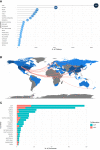
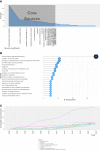
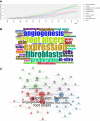

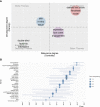
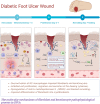

Similar articles
-
Global trends in publications regarding macrophages-related diabetic foot ulcers in the last two decades.World J Diabetes. 2024 Jul 15;15(7):1627-1644. doi: 10.4239/wjd.v15.i7.1627. World J Diabetes. 2024. PMID: 39099825 Free PMC article.
-
Worldwide Research Trends on Diabetic Foot Ulcers (2004-2020): Suggestions for Researchers.J Diabetes Res. 2022 Jan 27;2022:7991031. doi: 10.1155/2022/7991031. eCollection 2022. J Diabetes Res. 2022. PMID: 35127951 Free PMC article.
-
A Bibliometric Analysis of Global Research Production Pertaining to Diabetic Foot Ulcers in the Past Ten Years.J Foot Ankle Surg. 2019 Mar;58(2):253-259. doi: 10.1053/j.jfas.2018.08.052. Epub 2019 Jan 15. J Foot Ankle Surg. 2019. PMID: 30658958 Review.
-
Trends and prospects in nursing care for diabetic foot: A bibliometric analysis from 2003 to 2023.J Tissue Viability. 2024 Nov;33(4):550-560. doi: 10.1016/j.jtv.2024.07.008. Epub 2024 Jul 19. J Tissue Viability. 2024. PMID: 39038996
-
Role of fibroblast plasticity and heterogeneity in modulating angiogenesis and healing in the diabetic foot ulcer.Mol Biol Rep. 2023 Feb;50(2):1913-1929. doi: 10.1007/s11033-022-08107-4. Epub 2022 Dec 17. Mol Biol Rep. 2023. PMID: 36528662 Review.
Cited by
-
A comprehensive characterization of metabolic signatures-hypoxia, glycolysis, and lactylation-in non-healing diabetic foot ulcers.Front Mol Biosci. 2025 Jul 9;12:1593390. doi: 10.3389/fmolb.2025.1593390. eCollection 2025. Front Mol Biosci. 2025. PMID: 40703704 Free PMC article.
-
Global Trends in Diabetic Foot Research (2004-2023): A Bibliometric Study Based on the Scopus Database.Int J Environ Res Public Health. 2025 Mar 21;22(4):463. doi: 10.3390/ijerph22040463. Int J Environ Res Public Health. 2025. PMID: 40283692 Free PMC article. Review.
-
Mapping intellectual structures and research hotspots of chronic wound in global perspective.Regen Ther. 2025 May 17;30:47-62. doi: 10.1016/j.reth.2025.05.002. eCollection 2025 Dec. Regen Ther. 2025. PMID: 40491561 Free PMC article.
-
Global trends in publications regarding macrophages-related diabetic foot ulcers in the last two decades.World J Diabetes. 2024 Jul 15;15(7):1627-1644. doi: 10.4239/wjd.v15.i7.1627. World J Diabetes. 2024. PMID: 39099825 Free PMC article.
-
The role of apoptosis in spinal cord injury: a bibliometric analysis from 1994 to 2023.Front Cell Neurosci. 2024 Jan 16;17:1334092. doi: 10.3389/fncel.2023.1334092. eCollection 2023. Front Cell Neurosci. 2024. PMID: 38293650 Free PMC article.
References
-
- Saeedi P, Petersohn I, Salpea P, Malanda B, Karuranga S, Unwin N, et al. . Global and regional diabetes prevalence estimates for2019 and projections for2030 and2045: Results from the international diabetes federation diabetes atlas, 9th edition. Diabetes Res Clin Pr (2019) 157:107843. doi: 10.1016/j.diabres.2019.107843 - DOI - PubMed
Publication types
MeSH terms
LinkOut - more resources
Full Text Sources
Medical
Miscellaneous

